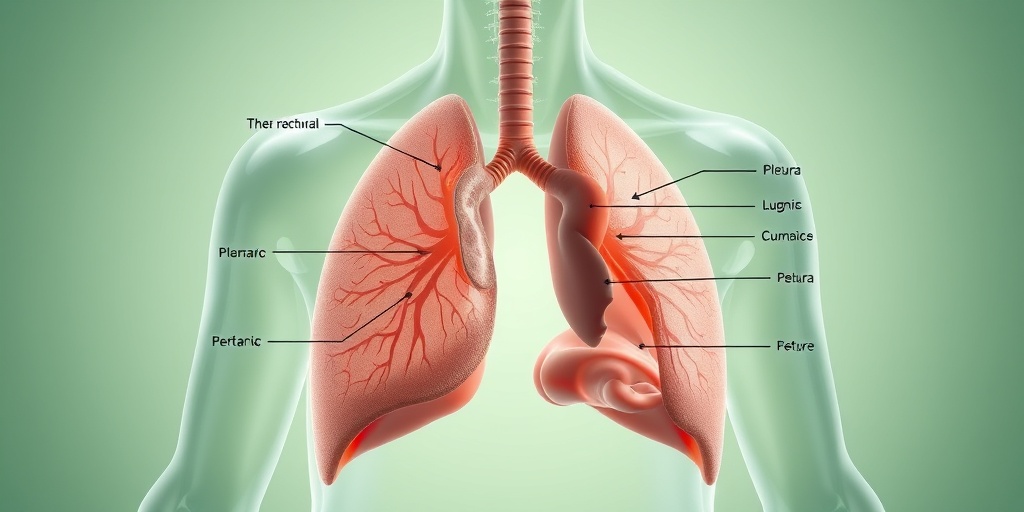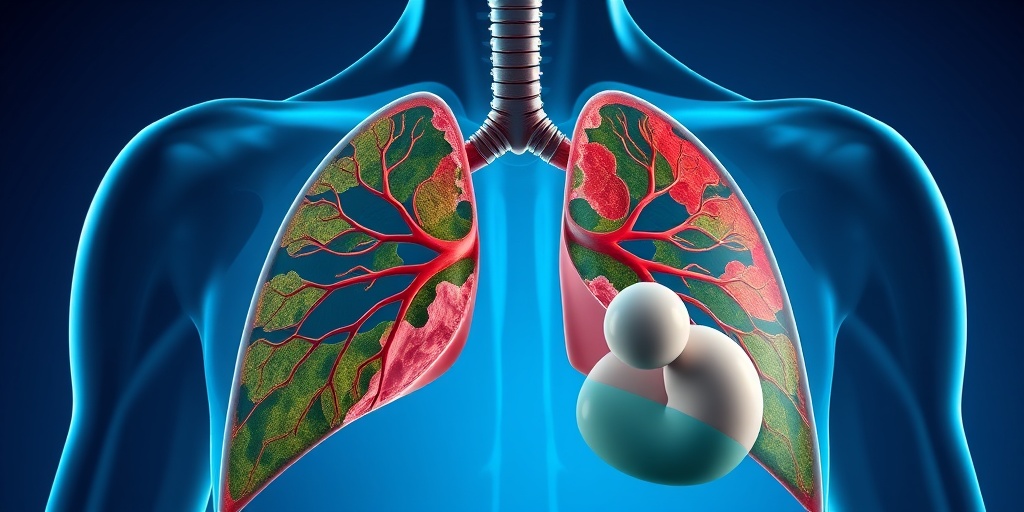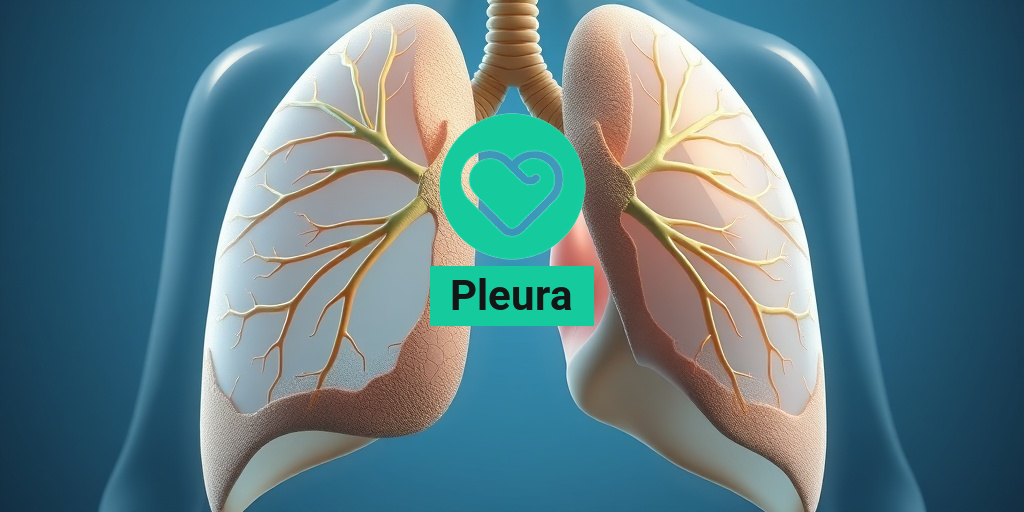What Is the Pleura?
The pleura is a vital component of the respiratory system, playing a crucial role in the mechanics of breathing. This double-layered membrane surrounds the lungs and lines the chest cavity, providing a protective barrier while facilitating smooth lung movement. Understanding the pleura is essential for grasping various respiratory conditions, including pleural effusion and pleurisy.
Essentially, the pleura consists of two layers: the visceral pleura, which directly covers the lungs, and the parietal pleura, which lines the inner chest wall. Between these two layers is a small space known as the pleural cavity, filled with pleural fluid. This fluid acts as a lubricant, allowing the lungs to expand and contract effortlessly during breathing.
Functions of the Pleura
The pleura serves several important functions:
- Protection: The pleura acts as a protective layer for the lungs, shielding them from infections and injuries.
- Facilitation of Breathing: The pleural fluid reduces friction between the lung surfaces and the chest wall, enabling smooth respiratory movements.
- Pressure Regulation: The pleura helps maintain the negative pressure within the pleural cavity, which is essential for lung inflation.
When the pleura becomes inflamed or infected, it can lead to conditions such as pleuritis or pleural effusion, which can significantly impact respiratory function. For more detailed information on these conditions, you can explore resources like Yesil Health AI, which provides evidence-based health answers.
Pleura Anatomy
The anatomy of the pleura is intricate and essential for understanding its role in respiratory health. Let’s delve deeper into its structure and components.
Layers of the Pleura
The pleura consists of two main layers:
- Visceral Pleura: This inner layer tightly adheres to the surface of the lungs. It is highly sensitive to pain and is responsible for the sensation of chest pain during pleural inflammation.
- Parietal Pleura: This outer layer lines the thoracic cavity and is less sensitive to pain. It is divided into several regions, including the costal pleura (lining the ribs), mediastinal pleura (surrounding the mediastinum), and diaphragmatic pleura (covering the diaphragm).
Pleural Cavity and Fluid
Between the visceral and parietal pleura lies the pleural cavity, which contains a small amount of pleural fluid. This fluid is crucial for:
- Lubrication: It reduces friction during lung expansion and contraction.
- Surface Tension: It helps maintain the lung’s adherence to the chest wall, preventing collapse.
In healthy individuals, the pleural cavity contains about 10-20 milliliters of pleural fluid. However, various conditions can lead to an accumulation of excess fluid, known as pleural effusion. This can result from infections, heart failure, or malignancies, and may require procedures like pleural drainage or pleurapunktion to remove the fluid.
Common Conditions Affecting the Pleura
Several medical conditions can affect the pleura, leading to significant health issues:
- Pleurisy: Inflammation of the pleura, often causing sharp chest pain during breathing.
- Pleural Effusion: Accumulation of fluid in the pleural cavity, which can cause difficulty breathing and chest discomfort.
- Pleura Empyema: A collection of pus in the pleural cavity, usually due to infection.
- Pleural Mesothelioma: A rare and aggressive cancer affecting the pleura, often linked to asbestos exposure.
Understanding the anatomy and function of the pleura is essential for recognizing and addressing these conditions. If you experience symptoms such as persistent chest pain or difficulty breathing, it is crucial to seek medical attention promptly.
In conclusion, the pleura is a remarkable structure that plays a vital role in respiratory health. By understanding its anatomy and functions, we can better appreciate the complexities of our respiratory system and the importance of maintaining lung health. For more information on respiratory health and related conditions, visit Yesil Health AI for reliable, evidence-based answers.

Pleura Functions
The pleura is a vital component of the respiratory system, playing a crucial role in the overall function of the lungs. This double-layered membrane surrounds the lungs and lines the chest cavity, providing both protection and support. Understanding the functions of the pleura can help us appreciate its importance in maintaining respiratory health.
1. Protective Barrier
One of the primary functions of the pleura is to act as a protective barrier for the lungs. The pleura consists of two layers: the visceral pleura, which covers the lungs, and the parietal pleura, which lines the chest wall. This structure helps to shield the lungs from external injuries and infections, ensuring that they remain healthy and functional.
2. Facilitating Lung Expansion
The pleura also plays a significant role in facilitating lung expansion during breathing. The space between the two layers of the pleura, known as the pleural cavity, contains a small amount of pleural fluid. This fluid reduces friction between the layers as the lungs expand and contract, allowing for smooth and efficient breathing. Without this fluid, the lungs would struggle to move freely, leading to discomfort and respiratory issues.
3. Pressure Regulation
The pleura helps maintain the necessary pressure within the pleural cavity, which is essential for proper lung function. This negative pressure allows the lungs to remain inflated and prevents them from collapsing. When the pleura is compromised, such as in conditions like pleural effusion or pleurapunktion, the pressure balance can be disrupted, leading to breathing difficulties.
4. Role in Gas Exchange
While the pleura itself does not participate directly in gas exchange, its proper functioning is crucial for the lungs to perform this vital process effectively. By ensuring that the lungs can expand and contract without obstruction, the pleura indirectly supports the exchange of oxygen and carbon dioxide in the alveoli, the tiny air sacs in the lungs.
Pleura Conditions
Various conditions can affect the pleura, leading to significant health issues. Understanding these conditions is essential for early detection and treatment. Here are some common pleura-related conditions:
1. Pleural Effusion
Pleural effusion occurs when excess fluid accumulates in the pleural cavity. This condition can result from various causes, including heart failure, infections, or malignancies. Symptoms may include shortness of breath, chest pain, and a persistent cough. Diagnosis typically involves imaging tests, such as chest X-rays or ultrasounds, and treatment may require pleural drainage to remove the excess fluid.
2. Pleurisy
Pleurisy is an inflammation of the pleura, often caused by infections, autoimmune diseases, or lung conditions. This inflammation can lead to sharp chest pain, especially during breathing or coughing. Treatment usually focuses on addressing the underlying cause and may include anti-inflammatory medications to relieve pain.
3. Pleural Empyema
Pleural empyema is a more severe condition characterized by the accumulation of pus in the pleural cavity, often due to bacterial infections. Symptoms may include fever, chills, and severe chest pain. Treatment typically involves antibiotics and may require surgical intervention to drain the pus and prevent complications.
4. Pleural Mesothelioma
Pleural mesothelioma is a rare but aggressive cancer that affects the pleura, often linked to asbestos exposure. Symptoms may include difficulty breathing, chest pain, and unexplained weight loss. Early diagnosis is crucial for improving outcomes, and treatment options may include surgery, chemotherapy, and radiation therapy.
5. Pneumothorax
A pneumothorax occurs when air enters the pleural cavity, leading to lung collapse. This condition can result from trauma, lung disease, or spontaneously without any apparent cause. Symptoms include sudden chest pain and shortness of breath. Treatment may involve observation for small pneumothoraces or procedures to remove the air in more severe cases.
Understanding the functions and conditions related to the pleura is essential for maintaining respiratory health. If you experience any symptoms related to pleural conditions, it is crucial to seek medical attention promptly. 🩺💙

Pleura Symptoms
The pleura is a vital component of the respiratory system, consisting of two layers of tissue that envelop the lungs and line the chest cavity. When issues arise within the pleura, such as inflammation or fluid accumulation, various symptoms can manifest. Understanding these symptoms is crucial for early detection and treatment.
Common Symptoms of Pleural Conditions
Individuals experiencing pleural issues may present with a range of symptoms, including:
- Chest Pain: This is often sharp and may worsen with deep breaths, coughing, or sneezing. It can be a sign of pleuritis or pleural effusion.
- Shortness of Breath: Difficulty breathing can occur if fluid accumulates in the pleural space, leading to a condition known as pleural effusion.
- Cough: A persistent cough may develop, which can be dry or productive, depending on the underlying cause.
- Fever: In cases of infection, such as pleuritis or pleuraempyem, a fever may accompany other symptoms.
- Fatigue: General feelings of tiredness and weakness can occur, particularly if the body is fighting an infection.
Specific Conditions and Their Symptoms
Different pleural conditions can present unique symptoms:
- Pleuritis: Inflammation of the pleura often leads to sharp chest pain and difficulty breathing.
- Pleural Effusion: This condition involves fluid accumulation in the pleural space, causing shortness of breath and chest discomfort.
- Pleuraempyem: A collection of pus in the pleural space, typically due to infection, can cause severe chest pain, fever, and chills.
- Pleuraerguss: This term refers to the presence of excess fluid in the pleural cavity, which can lead to similar symptoms as pleural effusion.
Recognizing these symptoms early can lead to timely medical intervention, which is essential for effective treatment. If you experience any of these symptoms, especially in combination, it is important to consult a healthcare professional for further evaluation. 🩺
Pleura Diagnosis
Diagnosing pleural conditions involves a combination of medical history, physical examination, and various diagnostic tests. Understanding the diagnostic process can help patients feel more informed and prepared.
Initial Assessment
The diagnostic journey typically begins with a thorough medical history and physical examination. During this assessment, healthcare providers will:
- Review Symptoms: Discuss the symptoms you are experiencing, their duration, and any factors that worsen or alleviate them.
- Conduct a Physical Exam: Listen to your lungs with a stethoscope to detect abnormal sounds, such as decreased breath sounds or pleural friction rub.
Diagnostic Tests
Depending on the initial assessment, several tests may be ordered to confirm a diagnosis:
- X-rays: A chest X-ray can reveal fluid accumulation (pleural effusion) or other abnormalities in the pleura.
- Ultrasound: This imaging technique is particularly useful for assessing pleural effusion and guiding procedures like pleurapunktion (thoracentesis).
- CT Scan: A computed tomography (CT) scan provides detailed images of the chest, helping to identify the extent of pleural disease.
- Pleurapunktion: This procedure involves inserting a needle into the pleural space to remove fluid for analysis, which can help determine the cause of pleural effusion.
Laboratory Analysis
If fluid is obtained through pleurapunktion, it will be sent to a laboratory for analysis. This analysis can help identify:
- Infection: Presence of bacteria or other pathogens.
- Cancer Cells: Indications of pleuramesotheliom or other malignancies.
- Biochemical Markers: Levels of proteins, glucose, and other substances that can indicate the nature of the effusion.
Accurate diagnosis is essential for determining the appropriate treatment plan. If you suspect you have a pleural condition, seeking medical advice promptly can lead to better outcomes. 🌟

Pleura Treatment Options
The pleura is a vital component of our respiratory system, consisting of two thin layers of tissue that envelop the lungs and line the chest cavity. When issues arise in this area, such as pleural effusion or pleurapunktion, it’s essential to understand the available treatment options. Here, we’ll explore various treatments for pleural conditions, focusing on their effectiveness and application.
Pleural Effusion Management
Pleural effusion occurs when excess fluid accumulates in the pleural space, leading to discomfort and breathing difficulties. Treatment options for pleural effusion include:
- Observation: In mild cases, doctors may recommend monitoring the condition without immediate intervention.
- Medications: Diuretics can help reduce fluid accumulation, while anti-inflammatory drugs may alleviate symptoms.
- Pleural Drainage: This procedure involves inserting a needle or catheter to remove excess fluid, providing immediate relief. It’s often referred to as pleuradrainage.
- Pleurodesis: In cases of recurrent pleural effusion, this procedure involves the introduction of a sclerosing agent into the pleural space to adhere the pleura together, preventing future fluid buildup.
Pleurapunktion: A Diagnostic and Therapeutic Procedure
Pleurapunktion, or thoracentesis, is a procedure used to both diagnose and treat pleural effusion. During this procedure, a needle is inserted into the pleural space to withdraw fluid for analysis. This can help determine the underlying cause of the effusion, such as infection, malignancy, or heart failure. Additionally, it can provide immediate relief from symptoms.
Pleura Empyema Treatment
Pleura empyema is a more severe condition characterized by the accumulation of pus in the pleural space, often due to infection. Treatment options include:
- Antibiotics: These are crucial for treating the underlying infection.
- Chest Tube Placement: A tube may be inserted to drain the pus and facilitate lung expansion.
- Surgery: In severe cases, surgical intervention may be necessary to remove infected tissue or drain the pleural space effectively.
Pleura Mesothelioma: A Specialized Approach
Pleura mesothelioma is a rare but aggressive cancer affecting the pleura, often linked to asbestos exposure. Treatment typically involves a multidisciplinary approach, including:
- Surgery: To remove tumors and affected pleural tissue.
- Chemotherapy: To target cancer cells and reduce tumor size.
- Radiation Therapy: To kill remaining cancer cells post-surgery.
Pleura Health Tips
Maintaining pleura health is crucial for overall respiratory function. Here are some practical tips to keep your pleura in optimal condition:
Stay Hydrated
Drinking plenty of water helps maintain the fluid balance in your body, which is essential for pleural health. Proper hydration can also assist in thinning mucus, making it easier to breathe. 💧
Avoid Smoking
Smoking is detrimental to lung health and can lead to various pleural conditions. Quitting smoking can significantly reduce your risk of developing pleural diseases, including pleural effusion and mesothelioma.
Regular Check-ups
Routine medical check-ups can help detect any potential issues early. If you have a history of lung disease or exposure to asbestos, regular screenings are particularly important.
Practice Deep Breathing Exercises
Engaging in deep breathing exercises can enhance lung capacity and promote pleural health. Techniques such as diaphragmatic breathing can help expand the lungs and improve oxygen exchange.
Maintain a Healthy Diet
A balanced diet rich in antioxidants, vitamins, and minerals supports overall lung health. Foods like fruits, vegetables, and whole grains can help reduce inflammation and promote healing. 🥦🍎
Limit Exposure to Pollutants
Minimizing exposure to environmental pollutants, such as industrial chemicals and secondhand smoke, can protect your pleura and lungs. Consider using air purifiers and wearing masks in polluted areas.
By following these health tips and understanding treatment options, you can take proactive steps toward maintaining your pleura health and overall well-being. 🌟

Frequently Asked Questions (FAQ)
What is the function of the pleura?
The pleura is a vital membrane that surrounds the lungs and lines the chest cavity. Its primary function is to facilitate smooth movement of the lungs during breathing by providing a lubricated surface. This helps reduce friction between the lungs and the chest wall.
What is pleural effusion?
Pleural effusion refers to the accumulation of excess fluid in the pleural space. This condition can lead to difficulty in breathing and chest pain. It is often diagnosed through imaging tests and may require procedures like pleural drainage for treatment.
What causes pleural empyema?
Pleural empyema is a collection of pus in the pleural space, typically resulting from infections such as pneumonia. It can cause significant respiratory issues and may require medical intervention, including antibiotics and drainage procedures.
How is pleural drainage performed?
Pleural drainage is a procedure used to remove excess fluid or pus from the pleural space. This is typically done using a needle or a catheter, guided by imaging techniques. The procedure can help relieve symptoms and improve lung function.
What are the symptoms of pleural diseases?
- Shortness of breath – Difficulty breathing can occur due to fluid accumulation.
- Chest pain – Pain may be felt during breathing or coughing.
- Cough – A persistent cough may develop.
- Fever – Infections can lead to elevated body temperature.
Can pleural conditions lead to serious complications?
Yes, untreated pleural conditions can lead to serious complications, including respiratory failure, lung collapse, or chronic lung disease. Early diagnosis and treatment are crucial to prevent these outcomes.
What is pleurapunktion?
Pleurapunktion, or thoracentesis, is a procedure used to remove fluid from the pleural space for diagnostic or therapeutic purposes. It can help relieve symptoms and provide samples for testing to determine the underlying cause of pleural effusion.
How can I maintain pleural health?
Maintaining pleural health involves avoiding respiratory infections, quitting smoking, and managing chronic conditions like asthma or COPD. Regular check-ups with a healthcare provider can also help monitor lung health.
When should I see a doctor about pleural symptoms?
If you experience persistent shortness of breath, chest pain, or a cough that does not improve, it is important to consult a healthcare professional. Early evaluation can lead to timely diagnosis and treatment of potential pleural conditions.




